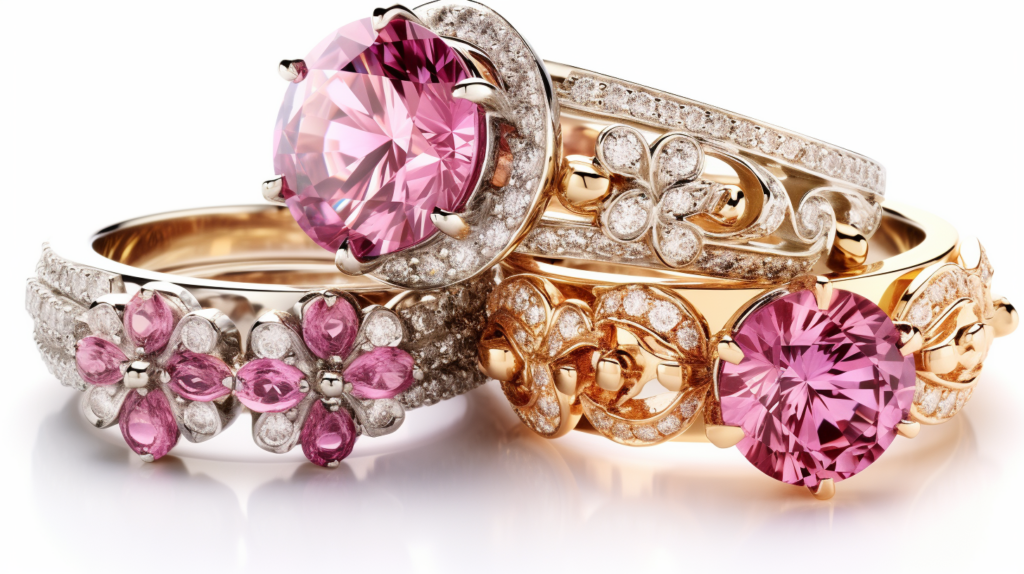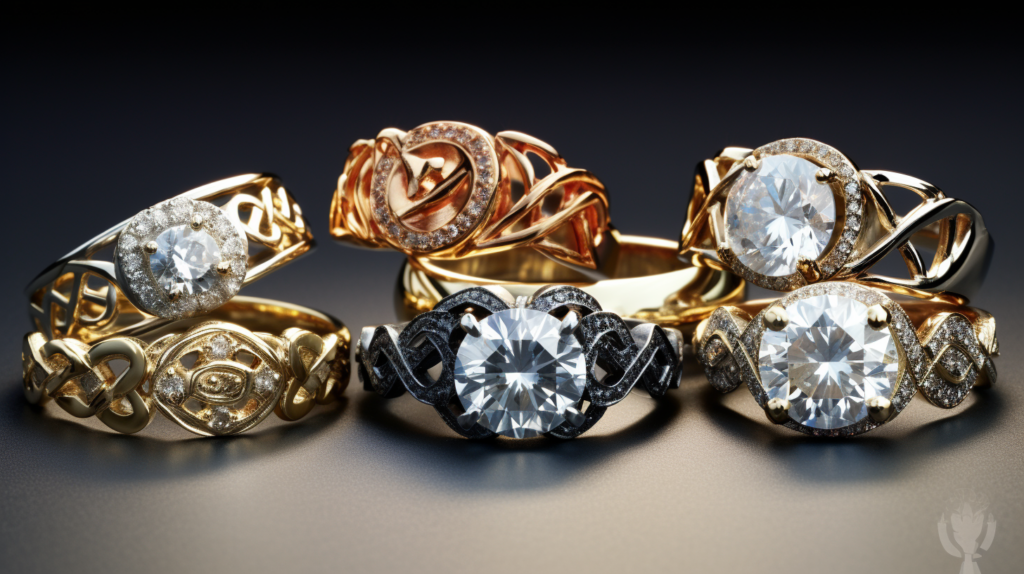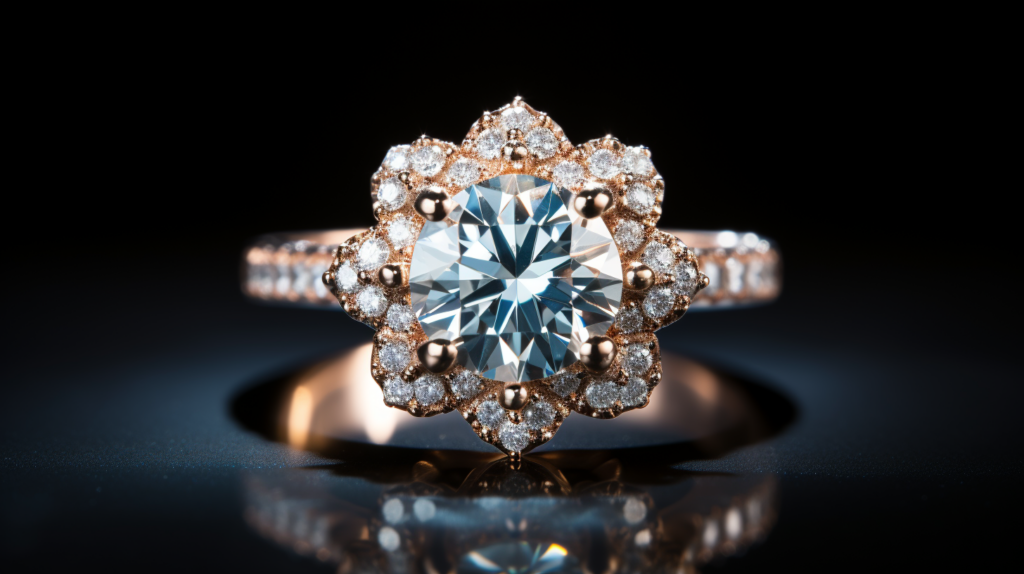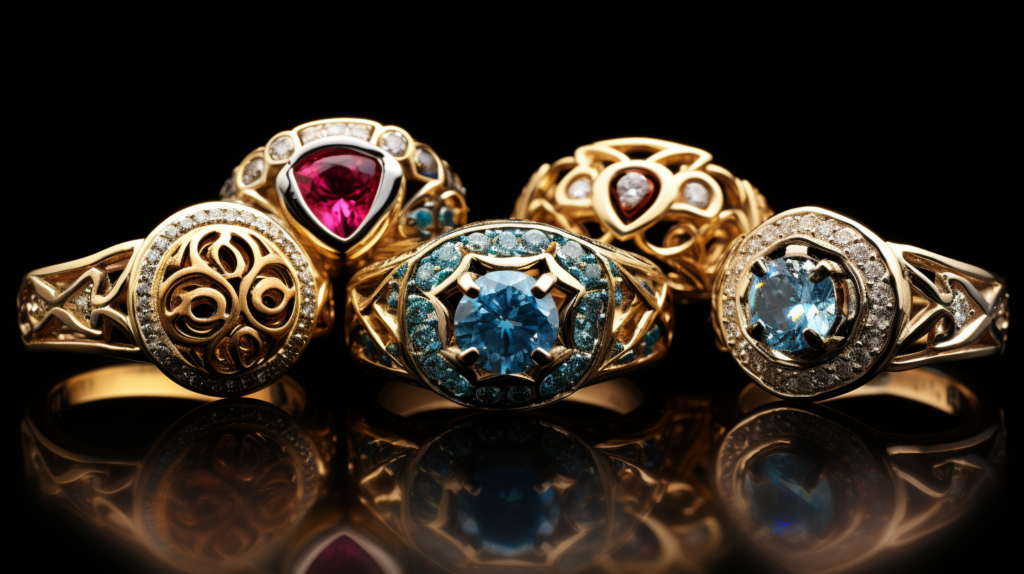Welcome to our page on global engagement rings.
Did you know couples globally love engagement rings? They represent love and dedication.
It’s intriguing to learn about engagement ring traditions and customs, each with its own meaning.
This Exploring Engagement Rings From Around the Globe set by BrighterGuide discusses the origins, history, and cultural customs of engagement rings across continents.
Related article: Stunning Engagement Rings Under 1000
Key Takeaways
- Engagement rings have a rich and diverse history, evolving from symbols of eternity in ancient Egypt to representations of a woman’s entitlement in ancient Rome.
- Engagement ring traditions vary widely across cultures, from iron bangles in India to beaded jewelry in Kenya, each reflecting the unique ways different societies celebrate love and commitment.
- Upgrading your engagement ring can add personalization and meaning, with options ranging from additional diamonds for sparkle to colorful gemstones for character.

In this post, we’ll explore:
The origins of the wedding ring
Let’s examine the wedding ring’s intriguing history.
Wedding rings have a long history, from the Ancient Egyptians who considered them as symbols of immortality to the Ancient Romans who saw them as a woman’s entitlement to her husband’s assets.
Even ancient Asians utilized puzzle rings to reveal infidelity.
The origins of the wedding ring reveal how this sign of love and devotion has changed.
The Egyptians
Exploring Egyptian rituals is crucial to understanding the wedding ring’s origins. The Egyptians believed rings symbolized eternity, making them ideal for eternal love and commitment. Their wedding rings were made of bone, ivory, leather, and hemp, demonstrating ancient inventiveness and resourcefulness.
These rings symbolized love and the couple’s cultural wedding rituals and jewelry designs. Egyptians valued engagement and had their own engagement ring traditions. Their exquisite engagement rings inspired wedding bands and diamond engagement rings.
Let’s investigate Roman practices and how they formed this beloved sign of love as we explore wedding rings.
The Romans
Romans believed wedding rings symbolized a woman’s entitlement to her husband’s property and heart. Rome’s engagement ring tradition originated with the exchange of two rings: one gold to represent the woman’s claim to her husband’s assets and one iron to represent his heart.
Western-style engagement rings are now common in many nations. Princess Diana’s sapphire and diamond engagement ring, given by Prince Charles, became famous worldwide. French ladies admire elegance and sophistication, thus they choose gemstone-adorned engagement rings.
Hindu women in India wear iron bangles and other jewelry on their wedding day, while western ladies choose diamond engagement rings.
In the next section regarding early Asian civilization, we explore how different cultures have shaped wedding bands.
Early Asian civilization
We learn that diverse Asian societies shaped the wedding ring as we study Early Asian civilisation and its origins.
Hindu cultures in India value wedding rings. Iron bangle bracelets are common wedding jewelry for Indian women.
Sri Lanka’s brilliant gemstones have enriched engagement rings.
Diamond mines in Eastern Europe supply the globe with the engagement ring gemstone.
Ornate beaded jewelry is a traditional African engagement gift.
These cultural influences have shaped engagement rings’ rich history and importance.

The History Of Engagement Rings
Let’s explore the fascinating evolution of engagement rings.
Diamond engagement rings, currently common in Western cultures, originated in Ancient Rome. Before the late Middle Ages, diamonds weren’t a sign of love and loyalty. In 1477, Archduke Maximilian of Austria ordered the first diamond engagement ring, cementing its status as a symbol of marriage.
Cultural and regional engagement ring designs vary tremendously. Engagement rings in Nordic countries like Sweden were modest gold or silver bands, and the bride received a diamond ring on her wedding day. American couples often wear diamond engagement rings due to Western influence.
Historical engagement rings have also used colored gemstones. French engagement rings often have sapphires, emeralds, and rubies to add personality.
Royal engagement rings are extremely popular worldwide. Royal engagement rings have inspired people worldwide, from Princess Diana’s sapphire and diamond ring worn by the Duchess of Cambridge to Meghan Markle’s trilogy ring with a Botswana center diamond.
The history of engagement rings shows their lasting symbolism of love and commitment. Engagement rings have changed over time to fit couples’ cultural preferences and interests.

Engagement Ring Traditions From Around The World
Explore the varied engagement ring customs around the world on a fascinating journey.
French brides wear jewel rings, whereas Irish brides wear Claddagh bands to show their relationship.
Kenya prefers beaded jewelry to rings, whereas China prefers money and Vietnam trades engagement rings.
These traditions demonstrate the cultural diversity of different places and the many ways love and devotion are celebrated worldwide.
Engagement ring traditions in Europe
Are sapphires, emeralds, and rubies common in French engagement rings? Absolutely! European engagement ring traditions differ each country, bringing character to the engagement. Some intriguing European engagement ring customs:
French ladies generally choose engagement rings with vivid gemstones for color and uniqueness.
Irish couples wear the Claddagh ring on multiple hands and placements to show their relationship status.
Simple gold or silver bands and a diamond ring on the wedding day are typical Swedish engagements.
German couples wearing promise rings while dating switch them to the right hand after marriage.
Each ring in a Greek engagement ring stack represents a relationship milestone.
These European engagement ring traditions showcase the beauty and diversity of engagement jewelry worldwide.
Let’s examine Africa’s distinctive engagement ring traditions.
Engagement ring traditions in Africa
Africa is our next stop in exploring engagement ring traditions from around the world.
South Africa has less engagement rings than other countries. Instead, other jewelry is highlighted.
Kenyan brides receive beautiful beaded jewelry instead of rings. These exquisite earrings symbolize the couple’s area and religion with decorative beading. This unique ritual showcases African culture and art.
Beaded engagement rings are beautiful and meaningful, despite their rarity.
Let’s visit Asia and discover its fascinating engagement ring traditions.

Engagement ring traditions in Asia
Let’s explore Asia’s fascinating engagement ring traditions. Engagement ring traditions on this diverse continent are as diverse as its nations. Here are some curious Asian engagement ring traditions:
Innovative Designs: Asia is recognized for its unusual engagement ring designs. Asian jewelers make unique creations with elaborate filigree and carvings.
Hindu Tradition: Indian Hindus value engagement rings. Brides wear Bichiya toe rings and other jewelry. These rings represent the bride’s marriage and are vital to the wedding attire.
Wide Variety: Asia has several engagement ring styles and materials. There are gold rings in India and diamond rings in Japan for everyone’s taste.
Vibrant Gemstones: Asian engagement rings generally use vibrant gemstones to provide color and personality. Stones like deep red rubies and vivid green emeralds make the rings stand out.
Strange Engagement: Countries like Thailand and Vietnam have strange engagement ring traditions. In Thailand’s thong mun ceremony, the groom gives the bride gold jewelry, including an engagement ring. The groom’s family offers the bride’s family gifts, and the groom gives the bride an engagement ring in Vietnam.
Asia’s diverse culture is reflected in engagement ring traditions. These traditions celebrate love and devotion in a unique and private way with colorful jewels and imaginative designs.

How To Upgrade Your Engagement Ring
One popular approach to improve your engagement ring is to add stones for a more personalized design. You can make a gorgeous ring that matches your style by adding more diamonds or gemstones. Your ring will gleam and include meaningful stones that represent you and your relationship with this upgrade.
This table shows engagement ring upgrade choices to inspire you:
| Upgrade Option | Description | Benefits |
| Additional Diamonds | Add more diamonds to your ring | Increased sparkle and brilliance |
| Gemstone Accents | Incorporate colorful gemstones | Adds a pop of color and personalization |
| Halo Setting | Surround the center stone with a halo | Enhances the appearance of the main stone |
When updating your engagement ring, deal with skilled jewelry designers who can help you develop a custom piece that matches your needs. The design might also incorporate Indian elements or family artifacts for tradition and meaning. Their expertise may turn your engagement ring into a modern masterpiece that reflects your love story.
Sources
BrighterGuide is dedicated to providing accurate and relevant information as you explore the wonderful world of diamonds and jewelry. To this end, our writers refer to primary information sources in building each article that appears on this website. These include, but are not limited to, published news articles, government portals, research papers, and more.
- Expatica. (2023, February 9). Wedding ring traditions from all around the world | Expatica. https://www.expatica.com/living/love/wedding-ring-traditions-107981/
- Friedman, U. (2021, August 2). How an ad campaign invented the diamond engagement ring. The Atlantic. https://www.theatlantic.com/international/archive/2015/02/how-an-ad-campaign-invented-the-diamond-engagement-ring/385376/